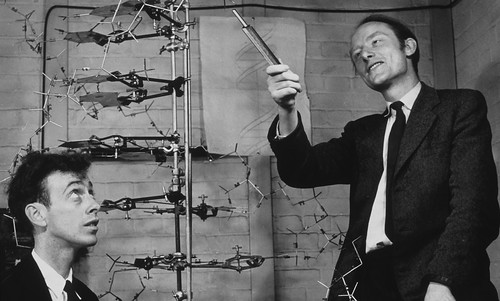-
1865
 Gregor Mendel, Austrian botanist, formulates his laws of inheritance after exploration of the inheritance of certain traits in pea plants, thus founding the science of genetics
Gregor Mendel, Austrian botanist, formulates his laws of inheritance after exploration of the inheritance of certain traits in pea plants, thus founding the science of genetics -
February 28, 1953
 Cambridge University scientists James Watson and Francis Crick announce that they have determined the double-helix structure of DNA, deoxyribonucleic acid, the molecule containing human genes
Cambridge University scientists James Watson and Francis Crick announce that they have determined the double-helix structure of DNA, deoxyribonucleic acid, the molecule containing human genes -
April 25, 1953Francis Crick and James D. Watson publish an article describing the double helix structure of DNA
-
1956Soviet Russian biologists Alexander Spirin and Andrey Belozersky predict existence of messenger RNA, a large family of RNA molecules that convey genetic information from DNA to the ribosome
-
1965Werner Arber, a Swiss microbiologist and geneticist, discovers restriction endonucleases, an enzyme that cuts DNA, thus laying foundation for recombinant DNA technology
-
1973American geneticists Stanley Norman Cohen and Herbert Boyer transfer the gene for frog ribosomal RNA into bacterial cells, thus starting genetic engineering
-
September 10, 1984Alec Jeffreys, a British geneticist, develops techniques for DNA fingerprinting and DNA profiling
-
1990Four-year-old Ashanthi DeSilva, who suffers from severe combined immunodeficiency, becomes the first patient to undergo successful gene therapy
-
May 18, 1994Food and Drug Administration concludes that Flavr Savr, a genetically modified tomato, is safe for food use, making it the first commercially grown genetically engineered food
-
April 14, 2003
 The Human Genome Project, an international scientific research project, is successfully completed, with 99 percent of the human genome sequenced to 99.99 percent accuracy
The Human Genome Project, an international scientific research project, is successfully completed, with 99 percent of the human genome sequenced to 99.99 percent accuracy -
May 7, 2010Scientists conducting the Neanderthal genome project announce that they have sequenced enough of the Neanderthal genome to suggest that Neanderthals and humans may have interbred
Monday, July 13, 2015
Genetics
Subscribe to:
Post Comments (Atom)
No comments:
Post a Comment